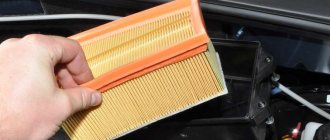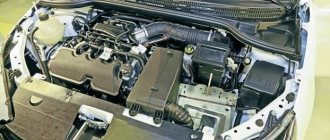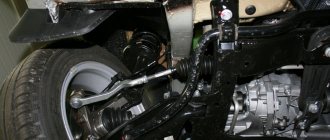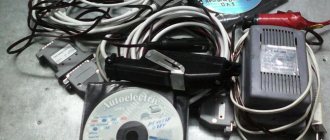The Russian station wagon LADA Largus, which first saw the light back in 2011, has since its appearance on the roads began to gain enviable popularity and expand its circle of fans. This was facilitated by the optimal set of technical and consumer qualities of this car, the list of which included: reliability, moderate cost, spaciousness and balanced equipment.
Over time, some annoying shortcomings appeared in the technical stuffing. This number can easily include the fifth-stage gear in a manual transmission; the 5th gear gear often needs to be replaced. It annoys the owner with noise, which is especially annoying on long trips.
Next, we will try to figure out how to replace the 5th gear gear.
How to change fifth gear gears?
Let's start by removing the oil pan protection.
Unscrew the bolts 10 mm, being careful not to twist them. And this is quite possible: they often sour well, so if you don’t want to bother with drilling them later or attaching the protection with self-tapping screws, you need to unscrew them carefully. However, regular WD40 can help. Drain the oil from the gearbox. Everything here is elementary, unless you confuse the engine crankcase and gearbox.
We unscrew the filler plug and tighten the drain (not forgetting to install a new sealing washer).
All that remains is to install the protection, and at the same time treat the protection bolts with any grease to prevent them from souring in the future.
Let's move on to the front left wheel. How to remove a wheel is unnecessary to explain.
We find the “lamb” on the fender liner at the top left of the wheel. We turn it counterclockwise and move the fender liner, fixing it directly on the bumper. Before us is a view of the gearbox, partially blocked by the subframe amplifier. It will also have to be removed by unscrewing two bolts.
We find the reverse sensor connector: it is screwed into the gearbox, there are simply no other sensors there. Remove the connector, then disconnect the wiring from the gearbox cover. It is usually attached with a plastic clamp that can be easily removed with wire cutters.
After making sure that nothing prevents you from removing the gearbox cover, unscrew its bolts. We wipe our hands and remove the lid to the side.
In front of us are the gears of the 5th gear, which we have to replace. The hardest thing is to remove these stars. It will be much easier to install new ones.
First we have to pull out the 5th gear shift fork. Therefore, we take a drift, a hammer and try to knock out the pin that secures it to the shaft. He will have to be beaten from the bottom up, which in itself is already interesting. Instead of a drift, an ordinary drill will do just fine: it’s not a shame to break it, and choosing the right diameter is not difficult. So, we begin to knock on the pin and watch how it slowly creeps up. There is no need to hit with a hammer with all your might; the box, although powerful, is quite fragile in places.
After the pin has flown out of the plug, we begin to remove it. She needs to be pulled towards herself. If you decide to do without special pullers, then, provided that you have an assistant, this is done as follows: one holds the fork with his hand, the second quietly taps the shaft through a drift. If you are careful but persistent, everything will work out and the fork will be in your hands.
Now we remove the gears, starting with the input shaft.
We unscrew the nut, then carefully pick up the washer behind it and pull it out of the seat. It happens that they fly away somewhere into the bowels of the garage after the pin, but if in addition to the sprockets you purchased a new nut, washer and pin, there is no need to crawl on your knees with a flashlight.
Next we try to remove the first gear from the input shaft. Here a special puller is used. But in its absence we act differently. You can try to carefully pry it off on both sides with ties and pull, but most likely this will not be effective. Then we take a regular universal puller and use it.
Replacing the Largus gear
Gearbox ratio: what it means and how to calculate it
Replacing Largus 5th gear gears is done as follows:
- The grease should be drained from the axle housing.
- Then you need to unscrew the bolts that secure the hub covers, unscrew the air supply angles from the axle shafts and remove the hub covers together with the seals and hoses.
- Next, use a puller to remove the axle shafts.
- Then unfasten the device and roll out the cart with the driving rear axle from under the car.
- The front bridge must be removed in the same way.
- As an addition, you need to disconnect the bipod rod of the steering mechanism from the steering cam lever on the left, the amplifier from the steering cam lever on the right.
- Disconnect and remove the shock absorber heads from the brackets.
- The next step is to use the arranged and attached device to raise the bridge and unscrew the nuts of the stepladders and disconnect the spring clamps at the front.
- Lower the front drive axle onto the cart.
If you don’t have car repair skills, then it would be right to contact a car service center, where the Largus spare part will be replaced by professionals, experienced car mechanics. This guarantees the quality of the repair. If you have questions regarding ordering auto parts, call us or write to our email address. We will deliver your order quickly in Moscow and the region.
Preparatory work
Gearbox ratio
According to Renault regulations, when working on the Largus gearbox, the nut washer and input shaft nut, the shift fork pin and the rear end bolt of the secondary shaft must be replaced. The cost of consumables for Largus is low. This is a plus for both Russian cars and Renault cars. However, as experience shows, most services do not do this, which can lead to other damage.
To replace the 5th gear gear you will need:
- standard set of wrenches, sockets and pullers;
- punches;
- small screwdriver;
- hammer;
- rubber mallet;
- means for cleaning and degreasing the surface of parts;
- FRENETANCHE thread locker.
It is recommended to carry out all work on a special lift; if one is not available, drive the car onto a pit or overpass. Before starting work, disconnect the battery.
Work progress
The work is carried out in the following order:
- The first step is to remove the engine crankcase protection. It is secured with six bolts, for which a 10mm wrench is used.
- If the gear is replaced without using a special lift, then the car must be jacked up from the front left wheel, and then some stable objects must be placed under the body in case the jack “collapses” and Largus falls. After this, the left front wheel and the right front fender liner are removed. After this, the gearbox oil is drained. To do this, use a size 8 wrench to loosen the drain plug and remove it, then drain the oil.
- After this, the left front shield that protects from dirt is removed, as well as the bolts that secure the power steering pipeline to the support and directly to it.
- The next step is to remove the connecting rod from the left suspension subframe. To do this, loosen the nut and remove the bolt, then with a sharp movement, unscrew the rod.
- The next step is to remove the light wiring from the engine crankcase. To do this, you need to disconnect the high beam connector and remove the wiring from the rear cover of the gearbox housing. It is under it that the fifth gear gear is located.
- After the wiring is removed, you need to remove the rear crankcase cover, which requires unscrewing the bolts.
- The cover should be removed carefully, since during removal there is a possibility of damaging the small plastic groove through which gearbox oil is supplied to the gears.
- In addition, you need to remember how much the fifth gear mounting pin protrudes; during assembly, it must be installed in the same way. This is important not only for Largus cars.
- It must be driven into the fifth gear shift fork using a hammer and a punch.
- The next step is to block the primary and secondary shafts. To do this, use the gearshift lever to engage first gear. After that, use the fifth gear fork to activate it. This procedure makes it easier to remove the input shaft nut and secondary shaft bolt. They are tightened tightly, so you will need a good wrench. After removing them, the input shaft nut is removed. This can be done with a screwdriver.
- The next step is to remove the secondary shaft bolt. This is best done using a TORX head.
- After removing the primary shaft nut and secondary shaft bolt, the fifth gear fork is removed. Then the synchronizer gear hub is removed. This is best done using a puller. It is worth noting that categorical care is needed here, since there is a possibility of damage to the gear itself.
- Then, no less carefully, the remaining parts are removed. This can be done without the help of tools. It is important to remember their location for subsequent assembly of the unit.
- For the next step, the secondary shaft bolt must be screwed back a few turns. He will have to play the role of support for the puller.
- The puller itself must be installed so that on one side it rests on the shaft bolt, while its legs go under the gear teeth. If the puller is installed correctly, removing it will not cause any problems. During the process, it will only be necessary to unscrew the bolt by one and a half turns of thread, since during extraction the gear will rest against it.
- After the fifth gear gear is removed, you need to inspect all parts for faults, as they may need to be replaced.
- Assembly is carried out in reverse order. First, you should clean the entire gearbox structure from dirt, both outside and inside. It is necessary to clean the splines of the gears and shafts with which they will fit, and then apply a fixing compound to them.
- The gear is seated and tapped using a rubber mallet. In this case, the blows must be applied along the axis of the shaft, so that it does not warp.
- The synchronizer clutch should be oriented towards the gearbox housing - the sharp ends of its teeth should be turned in this direction.
- Before installing the fork, you must engage fifth gear using the lever. After this, to ensure the alignment of the holes, the lever is switched to neutral mode, and the holes themselves are centered using a screwdriver.
- Then the fifth gear pin is inserted. As stated, it should perform the same as before disassembly. After this, the rear crankcase cover is put on, the wiring is returned to it, which is connected to the rear light switch connector. The connecting rod returns to its place, and its fastenings are tightened. After this, the power steering line, front mudguard, right front fender liner, front wheel and crankcase protection are returned to their place.
After completing the assembly process, you need to fill the gearbox oil, and the Largus car will be ready for use.
Source: ladaautos.ru
WHAT IS GOOD?
Compare lada largus and lada largus cross. We are not afraid of potholes. or still not?
The standard sixteen-valve box has both pros and cons. Among the advantages is the ability to provide dynamic acceleration and excellent elasticity. A car with a gross weight of nearly two tons and armed with only a 105-horsepower engine confidently stays in traffic, and in fifth gear it cheerfully picks up from 50 km/h - there is no need to shift often. On long hauls, sometimes you drive for several hours in fifth as if on automatic. It’s convenient, but you have to pay for it with increased noise and fuel consumption - and even when the speedometer needle has not even reached a hundred. Therefore, together with the specialists from our technical center, we decided to experiment with different gear ratios. After all, the design of the Largus transmission allows you to change fifth gear gears without disassembling the entire box or even removing the unit from the car. By the way, owners of Renault models (for example, Logan or Sandero), as well as Nissan-Almera, can similarly configure the top gear for themselves.
There are different sets of gears on sale, each of which will cost about 3,000 rubles. The craftsman will charge the same amount for a replacement. The beauty is that you won’t have to part with the car for a long time: a competent repairman can handle it in a couple of hours. Let's try!
Positive and negative sides
The standard version of the installed transmission has its advantages, but is not without its disadvantages.
The advantages of domestic owners include:
- enviable dynamic performance;
- correctly selected gear ratios, which allows movement in traffic without the need for frequent switching;
- • “long” fifth gear, which feels like an automatic transmission;
- • the ability of the same transmission to maintain torque when engaged with the input shaft even at a speed of 50 km per hour, without stalling the engine.
In order to “mitigate the situation,” specialists from the Lada Largus technical center often experimented, including replacing the fifth gear and selecting gear ratios. The design features of the transmission in the Lada Largus make it possible to replace the 5th gear gear without resorting to complete disassembly of the transmission unit.
Interesting! Owners of some Renault models, for example, Sandero or Logan, as well as owners of practical “Japanese” Nissan Almera, can also perform a similar experiment with this gear, as evidenced by numerous reviews from owners.
Replacing the fifth gear gear on Largus with your own hands
It is quite difficult to repair a gearbox with your own hands, so experts advise doing it at a service station. However, due to the design features of the gearbox and its location, replacing the 5th Largus gear can be done independently if you have certain skills and experience.
To do this, you must follow clear instructions:
- We put the car on a lift or hang it on stands.
- We remove the left front wheel and carefully, without breaking the clips and pistons, dismantle the engine compartment protection.
- Unscrew the upper fastening of the subframe bracket and move it to the side.
- We drain the oil from the crankcase by unscrewing the drain plug with a square wrench (it is advisable to tighten the plug after draining the oil).
- Remove the reverse sensor connector and the power steering mounting bracket.
- Unscrew the bolts securing the rear gearbox cover.
- We dismantle it, thereby opening access to the fifth gear gears.
Before you begin removing the gears, you need to secure them. To do this, pull the fork towards you and use a special mandrel to knock out the fixing pin. Then you need to return the fork to its original position and engage third gear, recessing the rod next to the fork. After this, pressing on the fork, we engage second gear - now the shafts are fixed.
In the final stage, loosen the bolt securing the gear on the secondary shaft, then unscrew the nut securing the gear on the input shaft, remove the retaining ring and unscrew the already loosened mounting bolt. We dismantle the fork along with the fifth gear clutch. Using a special puller, remove the drive gear, and similarly dismantle the gear on the secondary shaft. Having replaced a set of new gears with the desired gear ratio, we carry out the installation strictly in the reverse order.
It is important to remember that after installing all the removed parts, you should fill the gearbox with oil in accordance with the vehicle's operating instructions
replacing fifth gear gears - logbook Lada Largus VBH project rough 2015 on DRIVE2
Hello friends! For a long time I had plans to replace the fifth gear, everything didn’t work out, now one thing, then another, in general everything is like everyone else))). And I also wanted to get acquainted with the Larchik service station, so it turned out to combine these two events.
The agony of choosing gears was just as difficult; I spent a long time deciding which ones to install, reading reviews of people who had already made this choice, and settled on 0.
795 (not the fastest, but they carry a load), I called Alexander from Larchik, agreed on a replacement, I’m going to see them and I keep wondering: “How often do I travel laden? well, a couple of times a year on vacation with my family and fishing with friends, and the rest of the time I go alone, empty, and why do I need 0.795?”
At the last moment, I decided to set it to 0.756 and, as it turned out, it was not in vain that I changed my mind, and the speed is a little higher and the revs are lower, and this is the point of the whole idea.
I arrived in Larchik at the appointed time, everything was clear, they were already waiting for me, the lift was empty, there was no queue. master mechanic Andrey immediately got to work.
For those who are planning a replacement, I am posting the components
fifth gear LOGAN 0.756 driven 8200611301 1 3326fifth gear LOGAN 0.756 driven 8200607981 1 3326 cotter pin JB3, 7703067324 1 275 Gearbox secondary shaft bolt 8200110072 1 605 Guy rear input shaft Renault 7700115816 (replacement for 8200776177) original 1 420 Oil drain plug gasket Sasic 1640020 analogue 8200641648 1 20
Transmission oil ELF Tranself NFJ 75W80 GL-4+ (1 l) 7711427090 0.4 600 240
and a table for information
Everything was done quickly, well, for which I want to say thank you to Larchik, I also thank Alexander, he paid special attention to me, helped me figure out some small things absolutely free of charge, which is a rarity these days.
In general, the impressions from Larchik were good, I recommend it.
Yes, I forgot to write, all the components were provided by Larchik, I didn’t buy anything myself, the price was announced for everything (labor and components) ~13,000, but I almost forgot the most important thing, I was very pleased with the discount for club cars, everything cost me a little more than 10,000. THANK YOU Larchik .
Well, a photo of what was and what became
In general, I am satisfied, I recommend it to everyone. I hope my report will be useful to many. Likes and shares are welcome))) Beaver to everyone, as they say))) EVERYTHING WILL BE GOOD!
I forgot to indicate important information; when purchasing gears, count the number of teeth (there is often a discrepancy).
Source: https://www.drive2.ru/l/9254704/
Gear replacement process
- We place the car on an overpass or hang it with a lifting device, after which the fifth gear replacement begins.
- Remove the wheel from the front left side of the Lada Largus.
- We dismantle the plastic protective panel for the engine pan, removing the latches and pistons from the mounting sockets.
- We proceed to unscrewing a pair of bolts securing the subframe bracket. In this case, we completely unscrew the upper mounting bolt, and only loosen the lower one a little in order to further move the bracket to the side.
- We also release the fastening components located near the power steering pump and the transmission unit housing.
- Now we remove the reverse activation connector.
- We drain the oil from the box, having first unscrewed the plug on the drain neck and the three bolts holding the rear cover of the unit.
- We remove the specified cover without damaging the lubrication chute.
- Carefully knock out the fixing pin that holds the 5th speed fork with a rod.
- To ensure the ability to unscrew the gear fasteners, we resort to the need to lock the transmission shafts (primary and secondary). For this purpose, we pull back the fork and activate first gear.
- Using a puller (with two “claws”) we dismantle: the clutch, the synchronizer fork, the hub and the fifth gear itself.
- Now we move on to the same manipulations with the bolt and gear located on the secondary shaft of the Lada Largus.
- We replace the gears with prepared analogues and put everything back in place.
During installation, we recommend that you adhere to the rules below.
- We observe the tightening torques of the nuts: 80 Nm on the secondary shaft and 190 Nm on the primary shaft.
- We subsequently replace the oil in the transmission unit.
Characteristics of gearboxes in different modifications of Lada Largus
The above models of gearboxes have various modifications designed for installation on certain machines. For example, the JR5 517 gearbox is installed on a van with K4M and K7M engines. The JR5 549 is combined with the K4M engine in both a five- and seven-seat van. The JR5 551 gearbox works with the eight-valve engine on the station wagon, and the JH3 540 modification is usually installed in the five-seater Largus with an eight-valve engine.
Both gearbox models are made of an aluminum alloy housing, in which are mounted:
- differential;
- final drive gear;
- clutch housing.
Inside the Lada Largus gearbox housing there is a primary shaft with a set of drive gears and a secondary shaft with driven gears located next to it. To ensure coordinated operation of the primary and secondary shafts, synchronization rings are installed on them. The difference between the variations of speed boxes lies in the gear ratios between the primary and secondary shafts. The difference between the JH3 and JR5 models is the design of the clutch and gear shift control.
In the JR5 model, the transmission of force to the release bearing is carried out by a hydraulic system, which includes the main and working cylinders. The gearbox is controlled by two cables connected to the gear shift knob. At the same time, the cables are not interchangeable; each of them has its own functional purpose.
Before deciding on the purchase of a gearbox, it is necessary to evaluate the features of the automatic and manual transmission. A car with an automatic transmission has a number of advantages over a manual transmission, but it also has undeniable disadvantages.
Advantages and disadvantages of automatic transmission Lada Largus
| Advantages | Flaws |
| Excellent handling | Expensive repairs |
| Good acceleration dynamics | Frequent malfunctions |
| Multiple speed shift modes | High price |
| Ease of driving in urban environments | Inability to start the car when the battery charge is low (from a pusher) |
Therefore, before buying a Lada Largus with automatic transmission, you should weigh the pros and cons. In particular, it is necessary to understand in what conditions the car will be used most often.
Reliability jh3
The JH3 gearbox is considered a reliable unit, therefore it is still relevant in the automotive market. Car owners prefer cars with a structurally simple gearbox, partly because of its accessible and cheap maintenance. The disadvantages of manual transmission boil down to the lack of a high level of driving comfort.
The gear shift does not always occur clearly and quickly; sometimes there are jolts and jerking of the vehicle. Structurally, the unit has been fully studied, so even in the event of a serious breakdown, its overhaul will not be difficult. Usually the lever for switching from one speed to another becomes loose ahead of time, which leads to unclear switching.
Often, owners of Lada Largus with JH3 note the noisy operation of the manual transmission and a crunching sound when engaging reverse mode. Early wear of the synchronizers cannot be ruled out. If we close our eyes to some shortcomings, we will get decent mechanics that can go 200-300 thousand km without a single repair. There are known examples of cars that have covered about 500 thousand km on JH3 without a single repair. Much depends on your driving style and quality of service. The oil change must be carried out in accordance with the maintenance regulations.
New Lada: Adjusting Lada Largus headlights with your own hands - About auto parts, faults and choosing a car
Gear replacement process
- We place the car on an overpass or hang it with a lifting device, after which the fifth gear replacement begins.
- Remove the wheel from the front left side of the Lada Largus.
- We dismantle the plastic protective panel for the engine pan, removing the latches and pistons from the mounting sockets.
- We proceed to unscrewing a pair of bolts securing the subframe bracket. In this case, we completely unscrew the upper mounting bolt, and only loosen the lower one a little in order to further move the bracket to the side.
- We also release the fastening components located near the power steering pump and the transmission unit housing.
- Now we remove the reverse activation connector.
- We drain the oil from the box, having first unscrewed the plug on the drain neck and the three bolts holding the rear cover of the unit.
- We remove the specified cover without damaging the lubrication chute.
- Carefully knock out the fixing pin that holds the 5th speed fork with a rod.
- To ensure the ability to unscrew the gear fasteners, we resort to the need to lock the transmission shafts (primary and secondary). For this purpose, we pull back the fork and activate first gear.
- Using a puller (with two “claws”) we dismantle: the clutch, the synchronizer fork, the hub and the fifth gear itself.
- Now we move on to the same manipulations with the bolt and gear located on the secondary shaft of the Lada Largus.
- We replace the gears with prepared analogues and put everything back in place.
During installation, we recommend that you adhere to the rules below.
- We observe the tightening torques of the nuts: 80 Nm on the secondary shaft and 190 Nm on the primary shaft.
- We subsequently replace the oil in the transmission unit.
Procedure for replacing 5th gear
First, you should place the vehicle on a lift or stand, and then dismantle the front, left wheel. Next, the sequence of work will be as follows:
- By carefully removing the latches and pistons, the plastic shield that protects from dirt is released.
- Unscrew 2 bolts on the subframe bracket: the top one completely, the bottom one loosened a little and then moved to the side of the bracket.
- The fasteners located in the area of the power steering and gearbox are released, followed by the removal of the connector from the reverse switch.
- Afterwards, you need to drain the oil by first unscrewing the drain plug and 3 bolts located on the back of the gearbox cover.
- Now you need to carefully dismantle it, being careful not to damage the lubrication chute. The 5th gear fork retainer (pin) is carefully knocked out with a rod.
- Next, you will need to block the primary and secondary shafts, which will make it easier to unscrew the fasteners on the gears. To do this, the fork is pulled back and the first speed is turned on, followed by removing the nut on the input shaft.
- Using a two-jaw puller for convenience, the clutch, synchronizer fork, as well as the 5th speed hub and gear are dismantled.
- Now it’s the turn of the bolt on the secondary shaft to remove the gear. All.
All that remains is to replace the necessary gears and carry out careful assembly in the reverse order. It is recommended to take into account several rules during installation. For example, using a liquid fixative, process the splines on the drive gear. The nuts of the secondary and primary shaft should be tightened to 80 and 190 Nm, respectively. You will definitely need to replace the oil in the gearbox with a fresh copy.
Features of fifth gear on Largus
Along with the above malfunctions, Largus owners often have a desire to improve the performance of their car, or more precisely, to adapt it to personal requirements. In the main modification, the Lada Largus gearbox comes with a 16-valve engine. The fifth gear ratio (TR) is 0.892. This indicator indicates that the car can move confidently both in city traffic and outside the city. It easily picks up fifth gear from 50 km/h and dynamically reaches its upper speed limit, so there is almost no need to switch to fourth.
However, when driving for a long time at a speed of 90-100 km/h, increased noise occurs and increased fuel consumption is observed. This situation can be corrected by replacing the two fifth gears on the input and output shafts. Replacement takes place with gears that have a lower gear ratio, therefore, fewer teeth. These pairs of gears are sold in aftermarket gear ratios of 0.820, 0.795, 0.756 and 0.738. Experiments on replacing fifth gear gears were carried out by both AvtoVAZ and numerous car enthusiasts.
When using a pair with an IF of 0.820, the fifth gear becomes slightly shorter, as a result the car easily picks up a speed of 60 km/h both on an incline and when driving on a straight road. The noise from the gearbox operation becomes significantly lower.
Gears with a gear ratio of 0.795 slightly change the maneuverability of the Largus. When overtaking, you need to engage fourth gear more often to gain the desired speed. It is often necessary to switch to four when driving on the ground in a loaded car. As for the installation of gears with an IF of 0.756 and 0.738, they aggravate the listed disadvantages.
It is best to replace the factory gears with a pair with a 0.820 ratio.
Gear ratios of Lada Largus gearboxes
Depending on the Largus configuration, the standard 5th gear ratios may be different. Comparisons of different modifications in the table:
| Equipment | Station wagon 5 seats K7M (1.6l, 8kl), JH3 540 | Station wagon 7 seats K7M (1.6l, 8kl), JR5 551 | Station wagon 5 and 7 seats K4M (1.6l, 16cl), JR5 549 | Van JR5 517 |
| 1st gear | 3,727 | |||
| 2nd gear | 2,048 | |||
| 3rd gear | 1,393 | 1,321 | 1,393 | 1,321 |
| 4th gear | 1,029 | 0,971 | 1,097 | 0,971 |
| 5th gear | 0,820 | 0,795 | 0,892 | 0,738 |
| Reverse | 3,545 | |||
| Main couple | 4,214 | 4,5 | 4,214 | 4,928 |
About the disadvantages of gears
During a thorough and repeated analysis carried out by service centers, as well as based on numerous reviews from owners, it was established that such a malfunction is typical for the LADA Largus modification, which is equipped with a popular 1.6-liter engine (“K4M”) with a 16-valve head design . It is in this version of the engine tandem with the gearbox that the same gear can cause discomfort to the owner, which is why the 5th gear gear is replaced. The manufacturer is also familiar with this shortcoming, which subsequently manifested itself in its desire to use different combinations of not only engines with gearboxes, but also different options for the main pairs in transmissions (see table).
An interesting fact is that the cargo version of the LADA Largus, the so-called “van,” in fifth gear is capable of achieving a higher maximum speed in comparison with its passenger counterpart. The manufacturer intended everything just the opposite.
The noise emitted by the 5th stage gear not only annoyingly penetrated into the cabin, but also caused increased fuel consumption due to the presence of increased friction in the corresponding gearbox unit. That is why many owners of the model replace the fifth gear.
Pros and cons of a sixteen-valve
The standard version of the gearbox has a number of positive and negative aspects, which were also noted by car owners of the Russian station wagon. The advantages include:
- excellent dynamics indicators;
- confident movement in traffic, without the need for constant switching;
- over long distances, driving in fifth gear creates the feeling of an automatic transmission;
- the ability to pick up the clutch from the last gear even from 50 km/h.
The disadvantages of driving include a rather unpleasant noise level, as well as increased fuel consumption, which, given its cost in 2017, is a very unpleasant situation. As an experiment, specialists from the LADA technical center set the task of changing gear ratios. The structural features of the car allow you to change the 5th gear gears on the Lada Largus without affecting the integrity of the box, which means that the unit is kept in place without the need for disassembly.
Lada Largus
Over time, you get used to the shortcomings of the car you drive all the time. But there are exceptions to the rules. For two years now I have been using the Lada-Largus editorial station wagon and still cannot accept the heart-rending roar of its engine on country roads. On a long journey, you get tired of this tedious monologue, and the rising tachometer needle puts pressure not only on the psyche: you constantly think about increased fuel consumption. Judging by the numerous unflattering comments on thematic Internet forums, I’m not the only one who doesn’t like the too short fifth gear. Moreover, this problem mainly concerns the most popular passenger version with a 16-valve 1.6-liter K4M engine. Different boxes and main pairs are installed on Largus (see table). And in a passenger car with a sixteen-valve engine, fifth gear turns out to be the most high-torque. Even the van speeds faster in fifth gear. Although logically it should be the other way around.
THREE FROM THE CASTER
Editorial "Largus" tried on three pairs of gears with different gear ratios. In addition to the standard fifth gear of 0.892, we sequentially installed sets of 0.820 and 0.795 (see table). On a 300-kilometer test route, including highways and suburban roads, they compared the difference in fuel consumption and accumulated subjective assessments, which are sometimes even more interesting for the car owner than measurement data. For reliability, the expert assessment was supported by measurements at the Dmitrovsky test site. Test results and comments are presented below, including photographs, tables and diagrams.
0,892. The basic version provides excellent elasticity. Fifth gear can be used from 50 km/h even when fully loaded. You rarely have to shift down - the traction reserve is enough even for quick overtaking. But the noise of the engine operating at high speeds is annoying, even if you are moving no faster than the permitted 90 km/h: on long trips you quickly get tired.
Summary. The basic version is good for those who move mainly around the city, often with a full load
Checking the level and topping up
Before changing or adding lubricant, you should check the oil level in the box. This is not as difficult to do as many may think. If you have minimal experience and skills, you can easily cope with the task with your own hands. In the case of a Lada Largus car, for work you will need to take:
- a syringe that will be used to add the missing liquid;
- rags;
- an empty container for several liters;
- key square for 8;
- oil similar to what is in the box.
Special syringes are used, available in auto parts stores. Do not confuse them with medical syringes, which are not suitable for such purposes. Special topping and filling tools have a hose that allows easy access to the filler neck. When everything is ready, you can begin to assess the amount of oil in the box and add the missing amount of lubricating fluid to the Largus gearbox.
The work is carried out according to the following algorithm of actions:
Remove the engine protection. People often call it the central mudguard. The essence does not change from the name. Find the filler plug, which can often be easily unscrewed with a square wrench. Before opening the cap, place an empty prepared container under it to avoid spilled puddles of oil. According to the standards, the level should be located slightly below the filler hole. If it is less, then you will need to add the missing amount of gear lubricant. A syringe pre-filled with oil is inserted into the filler neck. Gradually pour in the viscous liquid. At some point, lubricant will begin to flow through the hole.
Wait until it stops running completely, then wipe everything with a rag and screw the plug back into place. During the process of checking and topping up, pay attention to the condition of the rubber O-ring on the plug. If the machine is used for a long time and actively, the ring may wear out. It is better to replace it immediately, since a worn seal will break the seal and the oil will gradually leak out
Such a ring costs about 5 - 10 rubles, so serious expenses for such repairs will not be required.
It is better to replace it immediately, since a worn seal will break the seal and the oil will gradually leak out. Such a ring costs about 5 - 10 rubles, so serious expenses for such repairs will not be required.
If you did everything correctly, the oil is not leaking anywhere and the gearbox is functioning normally, then the transmission fluid level is sufficient and you can continue to operate your car.
Brakes
Brake pads, Drum pads, Pad wear sensor, Pad repair kit, Pad spacer, Rear pads, Handbrake pads, Front pads, Brake linings, Brake discs, Rear brake discs, Front brake discs, Brake drum, Rear brake drum, Drum bearing, Brake hoses, Brake pipes, Brake caliper, Caliper repair kit, Rear caliper, Caliper guides, Front caliper, Caliper piston, Caliper boot, Caliper bracket, Hydraulic accumulator, Vacuum brake booster, ABS, ABS unit, ABS sensor, Vacuum pump, Brake pedal, Switch Brake Light, Air Brakes, Parking Brake, Handbrake Cable, Brake Cylinder, Master Cylinder, Brake Reservoir, Brake Service Cylinder, Rear Brake Cylinder, Front Brake Cylinder, Brake Cylinder Repair Kit
Lada Largus
Over time, you get used to the shortcomings of the car you drive all the time. But there are exceptions to the rules. For two years now I have been using the Lada-Largus editorial station wagon and still cannot accept the heart-rending roar of its engine on country roads. On a long journey, you get tired of this tedious monologue, and the rising tachometer needle puts pressure not only on the psyche: you constantly think about increased fuel consumption. Judging by the numerous unflattering comments on thematic Internet forums, I’m not the only one who doesn’t like the too short fifth gear. Moreover, this problem mainly concerns the most popular passenger version with a 16-valve 1.6-liter K4M engine. Different boxes and main pairs are installed on Largus (see table). And in a passenger car with a sixteen-valve engine, fifth gear turns out to be the most high-torque. Even the van speeds faster in fifth gear. Although logically it should be the other way around.
Replacing Largus 5th gear gear
The design of the Largus transmission allows you to change the 5th gear gears without disassembling the entire gearbox or even removing it from the car. You will need a gear puller, a hair dryer and two screwdrivers. If you have the necessary tools, the process takes no more than 2-3 hours. Video instructions:
When replacing gears with their own hands, car enthusiasts most often encounter difficulties when dismantling a small gear. Removing it without a special puller is not so easy, because... it sits on the shaft using a thread locker. In this situation, a hair dryer can be useful; after heating, the part will easily slide off. Don't forget to fill in new transmission oil.
Features of the JH3 gearbox
JH3 gearbox parts
The JH3 gearbox on the Lada includes a clutch housing, gearbox, and rear crankcase cover. Thanks to the clutch with a bearing located in the box, the clutch in the box is turned on and off. When changing speed modes, no extraneous noise is created. The Lada Largus gearbox provides the ability to accelerate quickly. The average working life of this box is approximately 250,000 km.
The gearbox control drive includes a rocker and a lever. It should be noted that there is a bevel differential. There is a drain plug at the bottom of the crankcase. It is controlled by a rigid rod. Its body is made of aluminum alloy. The JH3 540 version can be found in the five-seater Largus, which has an 8-valve engine.
Replacing the Lada Largus gearbox
The need to dismantle the box arises every time it is necessary to replace or repair the clutch on a car. On the Lada Largus, the gearbox is mounted in one unit along with the differential and final drive.
Replacing a transmission is one of the most difficult types of car repairs. We strongly recommend using the services of specialized technical centers for this.
When is Largus gearbox repair or replacement needed?
It is not always easy for an inexperienced driver to understand this. The gearbox and clutch work in tandem, and the symptoms of clutch and gearbox failure are often similar. Typical manifestations and causes of gearbox breakdowns:
- Increased vibration and extraneous noise in the gearbox. Possible weakening of the gearbox or engine mounting supports, insufficient oil level or mismatch of its brand, critical wear or damage to bearings or gearbox gears
- Oil leaking from under the gearbox. Damage or destruction of O-rings or seals
- Extraneous sound when changing gears, difficulty switching them on. Breakage of gear shift rods, inappropriate oil filled, weakened synchronizer springs, wear of blocking rings or synchronizers themselves
- Spontaneous gear shutdown. Large gap in synchronizer clutches, breakage of their springs or wear of gear shift forks
Only a technician can tell you the preliminary cause of the breakdown after inspecting and diagnosing the car. After dismantling and disassembling the gearbox, we will be able to accurately determine the malfunction and eliminate it.
Replacing fifth gear Largus
Largus has one not very pleasant feature - the gear ratio of the 5th gear is not very high.
Because of this, on long stretches on the highway, already at a speed of about 90 km/h, you have to turn the engine above 3000 rpm. Increases fuel consumption and noise inside the car.
Replacing the Largus 5th gear with another gear with a higher gear ratio will solve this problem.
The mechanics of our technical center will professionally replace 5th gear on a Lada Largus in literally 1.5-2 hours. Replacement is carried out without completely dismantling the gearbox; partial disassembly directly on the car is sufficient. The design of the gearbox allows this to be done, since the 5th gear is an overdrive and is located separately from the other gears.
There are several different factory 5th gears with different ratios that can be installed in the Largus gearbox.
But the acceleration dynamics will become even worse and you may have to switch to lower gears more often when overtaking. This must be taken into account when deciding whether to replace the 5th gear.
If you decide to replace the Largus fifth gear, our mechanics will offer you the most optimal replacement option among all available.
All work is performed only on modern equipment using professional tools and devices. We always use new fasteners and use special products for fixing, degreasing and cleaning threads. You can be sure of the excellent quality of all work performed.
Reviews about 5th gear gears
Based on feedback from owners of the Lada Largus car, as well as reviews, trials and tests, we have compiled a comparison table:
| PCH-5 | Shifting to 4th gear | Hill climbs in 5th gear | Confident acceleration in 5th gear | Summary |
| 0,892 | Rarely | Confident, even with a load | from 50 km/h | Loud engine noise on the highway. Only for the city and with load. |
| 0,820 | Sometimes for fast accelerations | Confident, even with a load | from 60 km/h | The howl of the engine on the highway has become less, but you still get tired of it. When trips are more often around the city and less often on the highway. |
| 0,795 | During fast acceleration | Confident, but without a load | from 65-70 km/h | To switch to 5th gear, you have to accelerate a little longer in 4th. The hum and howl from the engine and gearbox are within normal limits. Ideal city/highway option. |
| 0,756, 0,738 | Often | You should add gas | from 75-80 km/h | The gap between 4th and 5th gear is significant. Minimum noise level from the engine and gearbox on the highway. Suitable for driving on flat terrain with occasional overtaking. |
This modification is primarily used to reduce engine speed when driving in 5th gear. Fuel savings after such upgrades are not significant. If fuel consumption with PCH-5 0.892 was 7.4 l/100km, then with 0.795 it will decrease by 0.3 l and amount to 7.1 l/100km. If you expect that replacing the 5th gear of Largus will pay off in terms of gasoline savings, then you will have to wait several years.
How do you feel about this modification of the Lada Largus gearbox? Is it worth changing the 5th gear driven and driven gears? What gear ratios are best to choose? Let us remind you that you can increase the speed of the car in other ways, for example, by installing wheels of a different diameter. And to make long trips more comfortable, you can add an armrest.
Keywords: soundproofing Lada Largus | Lada Largus engine | Lada Largus gearbox
+26
Share on social networks:
Found an error? Select it and press Ctrl+Enter..











